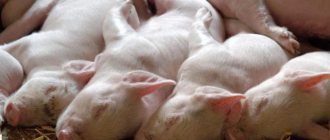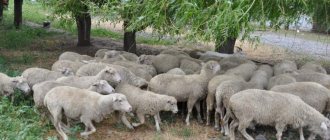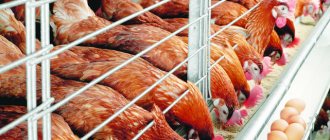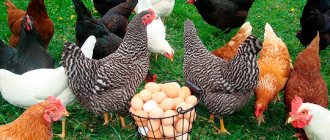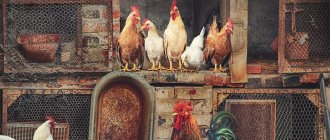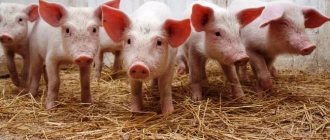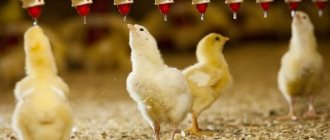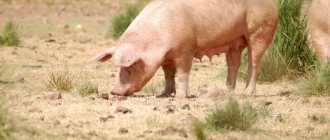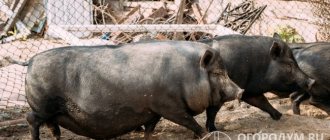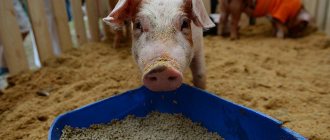A pig farming business plan offers general instructions and step-by-step steps to achieve results.
Farming is a way of life . It will not be possible to develop a passive business while located far from the countryside. Growing a small business will require hard work and commitment. Successful farmers gain experience over many years.
Beginners - the first year they work for self-sufficiency. They are searching for a sales market, choosing animal breeds for raising, and improving the technology of raising and fattening. They automate processes, solve the issue of their own feed supply, and receive financial support from the region. They decide to develop a family business or cooperate with other farmers to achieve results.
At the planning stage, it is worth deciding whether livestock and pig breeding fits into long-term plans. Analyze farming experience in the region, communicate with industry representatives, study the market and gain theoretical knowledge. At the planning stage, it is recommended to use objective information.
For example sites:
- Farming portal Fermer.ru
- Association of Farmers Akkor.ru
- Ministry of Agriculture in the region mcx.gov.ru
Why is it worth getting into pig farming?
According to official statistics, Russians consume about 8 million tons of meat per year, of which 2 million tons are pork - which is about a third of the entire meat market.
It is also necessary to remember the trade embargo introduced in Russia in 2014, which resulted in a shortage of commercial meat, most of which was imported pork. Along with this, the government began to support domestic producers as part of the “import substitution” policy. Therefore, farms can count on favorable business conditions.
As for the pig raising business itself, the following advantages can be highlighted:
- short period of raising an animal for slaughter (from six months to 9 months);
- the ability of one sow to bring 10-12 new individuals with a short gestation period of about 3.5 months;
- productivity - the weight of one carcass is about 1 quintal, of which 50-60 kg is meat and about 30 kg lard.
Taking into account all these factors, as well as the average cost of quality pork on the market, we can talk about the potential benefits that a pork business can bring to the owner. Moreover, you can start it in your personal yard, provided it is available.
Economic justification for pig farming business
In general, pigs have a number of biological characteristics that make breeding them a profitable business. The main feature of this feature is the fertility of pigs: in one farrow a sow can produce up to 20 piglets (but on average, about 12). In other breeds of domestic animals, the rates are 10 times lower. For example, a cow or ewe usually gives birth to one calf or lamb, respectively. The period of pregnancy (gestation) in a pig is 114-115 days, and the period of feeding is from 30 to 60 days.
Thus, in just one year a sow can produce at least two farrows and about 20-25 piglets. This figure can be increased by reducing the suckling period of piglets to 30 days. That is, in just two years it is quite possible to get five farrows and up to 60 piglets from one sow.
The precocity of pigs is explained by their high growth rates. Young animals grow 10-12 times faster than cattle. A piglet is born weighing an average of 1.2 kg. However, in just the first week of life, his weight doubles. With proper feeding, six-month-old pigs reach a live weight of 100 kg or more, which allows them to be used for meat. Thus, the “productivity” of one sow due to the offspring it bears is up to 3 tons of meat per year, which exceeds the similar indicators of cattle by almost 3.5 times. Despite this, pigs are quite economical animals in terms of nutrition. For every kilogram of growth, they spend 30-35% less feed than cattle. This is due to better digestibility of nutrients: for example, chicken absorbs only one-fifth of the feed, and pigs – over a third.
The slaughter yield (carcass weight relative to live weight) for pigs is 85%, and for young cattle - no more than 60%.
Required documents
Starting any business is inextricably linked with the preparation of documents. It is better to worry about this at the initial stage, so that later you can deal exclusively with the organization of production.
First of all, you need to register your pig farming business. It is best to choose the individual entrepreneur form - since with this form of organization it is easiest to maintain accounting and other reports. OKVED code – 01.23 “Pig breeding”.
To register as an individual entrepreneur you will need:
- application in form P21001;
- photocopies of all pages of the passport, certified by a notary;
- receipt of payment of state duty.
To register as an LLC (limited liability company) you need:
- application in form P11001;
- minutes of the meeting of founders with the decision to create an LLC;
- order on the appointment of a manager;
- company charter;
- government payment receipt duties.
The fee for registering an individual entrepreneur will be 5 times less (800 rubles) than for establishing an LLC (4 thousand rubles).
If you apply for the simplified taxation system (USN), the tax will be only 6%. For such a business it is possible and profitable to pay a single agricultural tax.
Important! If you have a subsidiary farm, you don’t have to register your business activity; the law does not prohibit a farmer from selling surplus product produced for himself. However, if the enterprise is initially planned as a business (we mean a commercial goal), it is better not to take risks.
In addition, you will need the following documents:
- permits from the State Fire Inspectorate, the Sanitary and Epidemiological Station and the Labor Inspectorate;
- resolution of the district or city administration on the possibility of erecting a building for a farm (for this you will need to provide a project for future construction);
- lease agreement or documents confirming ownership of the plot of land where the production will be located;
- license for pork production.
All documentation is completed before opening the pigsty and starting business. In this case, you will be able to avoid fines for illegal activities.
Legal registration of a pig breeding business
Domestic pig farming carried out for profit must be legal and legally registered. To do this, you will need to prepare a package of documents, which you can collect yourself or with the help of a specialist.
First you will need to register if the number of heads exceeds the 100 mark. If the farm is more modest than the indicated figure, then you can register a simple household plot.
For individual entrepreneurs, when registering a business, you will need to indicate OKVED - All-Russian Classifier of Types of Economic Activities - with the number “01.46.11”, which stands for “raising pigs for meat.”
Breeding pigs is a labor-intensive process, which, with the proper approach, will begin to bring a profit worthy of home entrepreneurship within a couple of years. When mastering pig farming, it is possible to grow from a small farm into an industrial enterprise that brings even greater income.
Site selection and construction of a pig farm
It is not permitted to build a building for keeping pigs in the city, so it is necessary to find a suitable site outside the city limits. It should be large enough to accommodate a pigsty and other buildings necessary for the business, and also be located at a sufficient distance from water sources.
The following characteristics are important when choosing:
- absence of infections in the soil;
- the soil slope must be at least 5% for wastewater drainage;
- breathable soil;
- groundwater depth – 2-3 meters;
- at least 1.5-2 km away from the nearest populated area.
The approximate area of the site for the construction of a pig farm is 3400 m2. It is worth paying attention to the possibility of laying communication routes, as well as the presence of nearby pastures for pigs.
After purchasing the land, it is necessary to begin the construction of a complex for keeping pigs. It is best to entrust the project to specialists, since this is a rather labor-intensive process, which also includes equipping the pigsty accordingly.
Business premises can also be purchased or rented. This will eliminate the need to build primary communications and equip the building. The disadvantage of this method is that usually abandoned Soviet pig farms with a large number (5-10 thousand individuals) of pigs are put up for sale. If there are no plans to expand the business so globally, it would be more logical to build the building from scratch.
The construction takes place under the supervision of representatives of the State Veterinary Supervision Service, who also participate in the reception of the farm. There are requirements for the construction of pig farms:
- There must be sanitary zones inside, no smaller than fire breaks;
- division of the complex into 3 sectors, between which there are sanitary barriers: in one there are places for keeping animals with veterinary stations (the distance between one and the other is at least 50 m), in the second there are outbuildings, in the third there are warehouses for storing roughage, bedding and silage ;
- the presence of bactericidal lamps, air filtration systems and treatment facilities at the place where pigs are kept;
- the presence of a fence around the complex with a height of at least 1.8 m.
You will have to meet the requirements for materials:
- safety for pigs;
- possessing heat-protective properties;
- vapor permeability and ability to accumulate condensate;
- resistance to external influences.
Choose the area of the pigsty based on 10-25 m2 of space for one adult. Inside there should be sectors for farrowing, rearing, fattening and boar. In one sector there can be 5-6 adult pigs or up to 10 sows without cubs at the same time. Keeping same-sex cattle in the same pen is not recommended. The sow and her cubs must be kept separately. It is recommended that all pigs be tagged.
The floor in the pigsty should be filled with concrete so that pigs cannot dig it up, the walls or partitions should be strong so that animals do not break them.
The building should be warm and well lit even in winter.
You also need to purchase transport for transporting animals and the resulting meat, and equip places for storing feed.
Where to start organizing a pig farm?
You need to start building a business by choosing premises. If you manage to rent a ready-made building, then the costs of improvement will be minimal. Average price per 1 sq.m. about 150 rubles. If, for example, the farm area is 800 sq.m., then the rent will be 120 thousand rubles. The dimensions of the building are determined by the number of heads on the future farm and age groups. Usually sows with piglets and animals raised for fattening are separated. With sufficient investment, a farm can be built from scratch. An area where groundwater lies deeper than 1.5 m is suitable for this. Their proximity will make the room excessively damp. In any case, the barn should be warm, without drafts or dampness. Communications in a building play an important role. Pigs are clean animals, so cleaning channels are laid in the room through which all dirt is removed.
Equipment for pig farms
Purchasing equipment for a pig farming business
To provide animals with everything necessary for life, you will need:
- Feeders – feeding feed all the time or regularly and in doses.
- Drinkers - you should choose scoop or cup ones and install them near the feeders.
- A ventilation system is necessary to ensure constant air movement and ventilation.
- Manure disposal system. The simplest and cheapest option is a self-alloying system, which you can build on your own.
Which breed to choose for breeding pigs for slaughter
First of all, you need to decide on what exactly the income from the business will be based on. There are 2 options possible:
- raising piglets for slaughter and subsequent sale of meat and lard;
- breeding boars and sows and selling them to farms.
The first is quite simple even for a novice businessman; in the second case, it will be difficult for a person who knows nothing about agriculture to sell a large number of young animals. Therefore, we will take a closer look at the first method of organizing a business.
Young stock for business should be purchased only from trusted and reputable breeders. Choose well-developed, active individuals with dry and clean pale pink skin. Buy pigs a little at a time from different breeders - this will avoid inbreeding of individuals.
Breeds are conventionally divided into three groups depending on the product subsequently obtained:
- meat-fat black: Ukrainian speckled, Novgorod;
- meat-fat white: Breitovskaya, Pietrain, Mangal, Muromskaya, large white;
- meat and bacon: Duroc, Don meat, Vietnamese potbellied, Landrace.
For meat, the most popular are Russian Large White pig and Landrace. Individuals of the Landrace breed already after 6-9 months weigh more than 100-120 kg, despite the fact that young piglets will produce a large amount of high-quality meat and have very little subcutaneous fat. Russian white pigs grow no less quickly, but will bring 3-5% fat, and the amount of meat will decrease by the same percentage.
When purchasing you also need to pay attention to:
- resistance of pigs to diseases;
- breed fertility;
- the ability to live in a given climate.
You need to buy pigs for a breeding business at the rate of 10 sows per 1 male.
Care and maintenance of pigs
To breed pigs, it is necessary to provide decent care for the animals, otherwise the business will not bring profit. To do this you will need:
- Regular feeding of balanced food. If pigs are bred at home not for themselves, but for sale, then for active and rapid growth they need to be fed not only with food waste and plant products, but also with balanced feed, which will have to be purchased from the manufacturer. In addition, animals need constant access to clean water.
- Good pigsties, which should be spacious, clean, insulated and draft-free. Also, pigsties should have separate pens for young piglets and sows.
- To develop a profitable business, animals must be cared for by hired specialists: veterinarians, livestock specialists and agronomists.
Equipment
For the decent development of domestic pig farming, as well as to facilitate animal care, you will need some equipment for small enterprises:
- automated feeders that independently control the number and time of serving portions;
- organic waste disposal systems;
- ventilation ducts and installations for premises with a number of pigs exceeding 10;
- systems that regulate and maintain optimal temperature conditions.
Breeding
Since pig breeding is designed for profit, it is necessary to constantly replenish the number of pigs. This requires mating of sows with males. Animals are ready for the breeding process already in the first six months of life, but experts recommend not allowing males to approach females earlier than after 10 months.
If the female is not ready for farrowing, this is fraught with the following consequences:
- death of offspring and sow;
- health problems in piglets and females;
- an increase in excess fat or underweight in the offspring.
The sow needs to be prepared for mating: wait until she is 10 months old, and fattened to a large size.
The process of mating a male and female must take place in a separate pen. Also, a separate place will be required when the sow farrows. In anticipation of the birth of piglets, the place must be cleaned and disinfected, the necessary instruments for childbirth must be prepared, and the presence of a veterinarian is also necessary.
Prevention and treatment of diseases
Pigs are susceptible to diseases that often lead to their death. To prevent a decrease in the number of individuals, it is necessary to carry out preventive measures:
- observation of the external state and behavior of individuals;
- control over the feeding process;
- regular rectal temperature measurement;
- regular cleaning of artiodactyl premises.
As for the treatment of infectious diseases, in some cases it is not carried out - the infected animal is simply killed. Some types of diseases are treated with antibiotics, serums, and vaccinations.
Watch the video, which talks about personal experience in breeding pigs for sale, the features of their keeping and feeding, and potential benefits:
Sales of finished products
To ensure that selling meat does not cause difficulties, you must take care of obtaining a quality certificate and a positive conclusion from a veterinary examination. To be sure that you will be able to sell the existing product, even at the stage of starting a business, find meat processing enterprises in the region and enter into a contract with them for the supply of products. You can also supply meat directly to stores, or organize your own pavilion or retail outlet.
Remember that in addition to meat and lard, you can also sell skins and manure - this will increase the profit from the pig business.
If possible, you can expand your business and organize a workshop for the production of canned food and semi-finished products to increase your profit.
Possible business problems and risks that need to be worked out at the planning stage
- High cost of the project, increase in cost at the implementation stage.
- Long payback period, lack of sales market.
- The risk of loss of animals of the main and circulating herds as a result of illness, non-compliance with feeding and housing conditions.
- Lack of qualified personnel in the region where the business operates.
- Low profitability due to the lack of its own feed, base, slaughterhouse, and land. Availability of credits and loans.
- Difficulty in obtaining certificates, licenses, and permits.
Selection of service personnel
How many employees you need to open a business depends on many factors. For example, it depends on whether you will sell meat, semi-finished products, or sell live animals. Also, the number of staff depends on the level of mechanization of production.
You need to take the selection of employees especially seriously if the owner does not have extensive experience and knowledge in the pork business.
The minimum staff will consist of:
- manager - usually the owner of the business;
- accountant;
- vet;
- pig farmer;
- livestock specialist;
- handyman
Usually, one person is enough for each of the positions, except for pig breeders and general workers. At the initial stage of the business, the owner can also act as an accountant if he has enough knowledge in this area.
Pig farm business plan: personnel
The issue of selecting highly qualified personnel for a pig farm is especially acute if you do not have the necessary knowledge in this industry.
To work in the state you need:
- Manager. This position can be taken on by the initiator of the business project himself. Responsibilities include: supervising the production process, monitoring reporting, managing other members of the pig farm team.
- Accountant. Responsibilities: records all financial transactions, maintains property records, makes payments to suppliers and customers, draws up reports, plans tax payments, maintains an accounting database. Must also comply with other management requests.
- Veterinarian. Responsibilities on a pig farm: examines animals, diagnoses their condition, searches for the causes of emerging diseases, carries out the necessary preventative measures, advises other employees on the rules of feeding and care, and is responsible for the sanitary examination of the livestock.
- Livestock specialist. Responsibilities: introduces new methods of breeding pigs, makes selections, creates and monitors compliance with the regime for keeping animals on the pig farm, supervises the breeding process, and keeps records of business productivity indicators.
- Pig farmer. Responsibilities on a pig farm: monitors the condition of the livestock, feeds the sow, performs auxiliary work, weighs and moves livestock, feeds the livestock, monitors manure removal, performs actions necessary to increase the production of offspring, sends fattened animals to slaughter.
- Handyman. Responsibilities: Ensures the completion of tasks necessary for the normal functioning of the pig farm. Delivers feed to animals, cleans premises, participates in field work, helps in driving livestock, loading and unloading them. Performs other assignments from senior management.
Market analysis
The demand for meat does not depend on the time of year and changes in income levels. They buy it every day, even during a crisis. It should be taken into account that among the total meat consumption, the share of chicken and pork together is 76%, of which only about 30% is pork consumption. This means that chicken producers must also be considered competitors.
Thanks to the introduction of the food embargo and government support, this business segment increases by 2-3% annually. According to statistics, pork production in Russia increased by 26% from 2012 to 2016. Economists also predict the possibility of increased demand due to rising prosperity.
All these reasons allow us to consider pig farming one of the most promising areas of agricultural business. However, a drop in demand is also possible under the following conditions:
- opening the country to the import of imported products;
- increase in the cost of pork at retail;
- falling standard of living.
Also evaluate the available pork producers in the region. Evaluate their competitive advantages and think about how you could win against them.
Feed selection
A livestock of 300 individuals consumes up to 35 tons of feed and up to 300 kg of mineral supplements per year. Weight gain directly depends on the quality of nutrition. Feeds are divided into three groups according to their effect on the taste of meat:
- Providing high quality meat: rye, millet, peas, sugar beets, nettles, alfalfa, milk and meat waste. Feed increases fat density and accelerates the growth of young animals.
- For medium quality meat - buckwheat, wheat and rye bran, corn. They are mixed with high-quality feed to reduce the cost of production.
- Reducing quality to a minimum level - oil cake, soybeans, oats. They are used together with alfalfa and sugar beets to fatten livestock for bacon.
Natural feeding is beneficial for keeping livestock of up to 200 individuals. For smaller numbers of pigs, purchase feed from suppliers. When purchasing compound feed, check with the manufacturer for a license and certificates for the products, and monitor the expiration date.
Advertising campaign
The most important advertisement of a livestock business will be the production of a high-quality product. However, to raise production to a higher level and not lack customers, this may not be enough, especially if there are other competitors in the region.
You can make your name known at agricultural and livestock exhibitions and forums. There is an opportunity not only to demonstrate your products, but also to establish partnerships with other colleagues and exchange experiences.
You can also create an online store with a description of business activities, product prices and a full catalog of goods and services. You can develop a loyalty program for regular customers.
Place advertisements in thematic publications and send mailings to the sales departments of enterprises working with meat products.
Pig farming in the world
To begin with, I decided to analyze the situation with pig farming in the world. It turned out that Germany is the leader in the production of pork for export and domestic consumption. To be honest, I was surprised because I expected to see Ukraine. Remember all these stories about Ukrainians and “lard in chocolate”? But no, the Germans outplayed everyone, and most of the farms with a number of queens from 3 to 5 thousand are family farms, organized precisely as a business, which indirectly proves the profitability of raising pigs at home. Inspiring, isn't it? In second place is Holland, although this country gave up the leadership to Germany relatively recently, and all because of the emergence of serious difficulties with manure disposal. Now they don’t fatten the piglets for meat, but export the young animals to the same Germans and everyone else. However, in this area too, Holland is significantly inferior to Denmark, which is the leader in the export of pigs (3/4 of all raised individuals). Poland, Belgium, France, Spain, Austria, Ireland and Croatia also produce pork, but in more modest quantities, and in Italy, generally, only for domestic consumption. In Slovakia, Hungary and the Czech Republic, industrial pig breeding has come to a standstill.
In our country and its closest neighbors, pork production is at a high level:
- In Russia, the share of pork in the total meat volume is 36%. For comparison: beef - 6.7%, poultry - 57.2%, goat meat - 0.1% (according to data from the IAA "IMIT" for 2018-2019).
- In Ukraine: pork - 43%, beef - 23.5%, chicken - 29.5, other meat - 4% (according to data from the State Statistics Service for the same period).
- In Belarus, pig meat accounts for 30% of the total balance.
Enterprise financial plan
Calculations of expenses, profitability and profitability are one of the most important sections that must be in a business plan. This will allow you to understand how much money is needed to start, as well as how long it will take for the business to pay off.
Table of one-time expenses
This article should include all costs incurred at the stage of starting a business:
- construction of the complex (with equipment) – 1.5 – 2 million rubles;
- paperwork – 20 thousand rubles;
- employee salary – 150 thousand rubles;
- purchase of feed for several months in advance - 200 thousand rubles;
- purchase of young animals (50 heads) – 170 thousand rubles;
- advertising – 50 thousand rubles.
- insurance contributions - 30-40 thousand rubles;
The total estimated amount will be 2.1 - 2.6 million rubles.
Monthly expenses table
The costs of the first month are already included in the calculation of one-time business costs, but subsequently it is necessary to calculate how much money will be spent monthly in order to plan the current budget and, if necessary, cut costs, optimize production processes, or increase product prices.
- employee salary – 150 thousand rubles;
- advertising – 20 thousand rubles;
- purchase of disinfectants and medications – 40 thousand rubles;
- livestock renewal – 50 – 200 thousand rubles. (varies depending on the total number of pigs);
- utility bills - 40 thousand rubles;
- purchase of feed - 25 thousand rubles.
The total monthly costs are about 0.5 million rubles.
Approximate starting capital
Opening a pig breeding requires certain initial investments, which, if the business develops successfully, will pay off in a short time (six months to a year). Next, we will present an approximate business plan for initial expenses, taking into account that the entrepreneur already has a plot of land:
- Construction and arrangement of 1 pigsty for 10 heads – 50,000 rubles.
- Purchase of 10 piglets at the age of two months – 30,000 rubles (the cost of 1 piglet starts from 2500-3000 rubles).
- Vaccination of animals against parasites – 3000 rubles.
- Purchase of feed for pigs designed for the entire feeding period - from 40,000 rubles.
- Other minor expenses – 5,000 rubles.
Thus, to start developing a livestock business, you will need to invest 120-130 thousand rubles.
Planned income and business profitability
Using these calculations, you can understand how long it will take for your business to pay off. This section must be in the business plan, especially if you do not plan to spend your own money at the initial stage, but take out a loan from a bank.
Revenue depends on whether you sell meat at retail, small wholesale or live weight. In the first case, you can earn 200-300 rubles per kg of meat and 100-150 rubles per kilogram of lard. You can also sell by-products for an average of 30 rubles/kg.
When selling a whole carcass, the price is set at 200 rubles. per kg without giblets, horns, hooves and heads. This means that on average you can earn 15-20 thousand rubles for one pig, and the cost of one especially is about 8 thousand rubles.
Without specific indicators, it is difficult to calculate possible revenue. However, a good indicator for a small pig farming business is a payback within 2-3 years and a profitability of about 25%.
You can recoup costs faster, but in the first years of business it is recommended to invest the profits in the development of the enterprise.
How much money do you need to start a business?
When you don’t have your own plot of land, you need to rent it. For a livestock of 50 pigs, 20 acres of land is enough, which will cost 30 thousand rubles. per month. Then the main expenses will follow:
- Construction of a pen - 300 thousand rubles;
- Equipment and communications - 400 thousand rubles;
- Purchase of 50 piglets - 600,000 rubles;
- Feed grain and additives - 10,000 rubles. per month;
- Unforeseen expenses - 60 thousand rubles.
If the business is not family-owned, then hiring workers (4-6 people) will cost up to 120 thousand rubles. If marketing firms are involved in selling products, it will cost about 25 thousand rubles. per month. You may need your own website for promotion and advertising, so a computer and website creation will cost up to 30 thousand rubles.
In general, to start a pig farm of 50 heads you will need 1.58 million rubles, and monthly expenses will be 250 thousand rubles (utilities, taxes, insurance, additional expenses, etc.).
Difficulties of farming
When starting such a business, you need to take into account possible risks specific to this area.
Swine fever
The African swine fever virus was first heard in Russia in 2007. The biggest problem is the lack of a vaccine that can cope with the disease. This means that if one animal gets sick, stopping the spread of the epidemic will be difficult, most often impossible. You will have to kill the entire livestock (contaminated meat cannot be sold), disinfect and completely clean the entire area. In this case, all pigs within a radius of 15-20 km from the source of the epidemic must be destroyed.
Epidemiologists believe that the destruction of livestock will solve the problem, while breeders are confident that these are unnecessary losses.
In general, it is not recommended to start a business in regions where outbreaks of swine fever epidemics have previously been recorded.
Recommendations and secrets of pig farming
The success of a business depends 50% on how well the entrepreneur studies the peculiarities of living and keeping animals. For the first stage of development you need to purchase:
- boars - 20 - 22 heads;
- sows - 125 - 135 heads;
- There must be at least 140 meat pigs (this is the basis for selling meat).
The work of a pig farm can be aimed at implementing two directions - meat production and raising young animals for resale. This will allow you to receive a stable income and replenish financial savings intended for further expansion and modernization of the business. The secret of success is that pigs destined for meat are fed intensively with high-quality feed. Young animals should be at least 25% of the total livestock, so sold heads are immediately replaced by new meat pigs.
It is recommended to purchase young animals in the first year from different farms in order to be able to choose the best breed and avoid crossbreeding within the same genus, which leads to diseases and weakening of the offspring. A quality pig breeding program must be developed by a veterinarian.
Taxes
There is an article in the federal law, according to which farmers must have a license to collect, process and transport waste from hazard classes 1 to 4. Fresh manure belongs to the 3rd class, and rotted manure to the 4th, so every farmer engaged in the pig breeding business must have such a document. The exception is for farms that completely use waste for their needs. In this case, they must annually certify the manure as agricultural fertilizer.
In addition, due to the environmental damage that pig farming can cause, owners of such businesses are required to:
- issue a waste passport;
- provide the development of a waste generation and recycling plan for a specific farm;
- negotiate waste processing with a specialized enterprise or organize it yourself;
- pay taxes on production that has a negative impact on the environment.
It is this factor that makes doing business very difficult for small farms, since the cost of waste disposal in some regions is either impossible or too expensive.
Purchase of piglets for breeding
It is beneficial to turn to breeding farms to purchase starter stock for farming. Breeding farms provide guarantees, ensure proper maintenance of offspring, and advise on issues of maintenance, feeding and selection of breeds for breeding.
As a rule, such farms ask for advance payment and pre-order 3-6 months in advance. A private owner cannot give such guarantees. As a result, there is a risk of getting a sick animal that is not suitable for breeding and is unable to gain the required weight. The entrepreneur will suffer losses .
Industrialization of farms
More than half of all pork in Russia is produced by the 20 largest companies, and only 40% of the market remains free for small entrepreneurs and business newcomers. It is quite difficult to compete with monopolists, since they have the ability to mechanize production and invest large sums in development. Because most government subsidies also go to the country's largest farms, this makes competition difficult for those who own small pork businesses.
What breeds to breed
There are many breeds of pigs and it is necessary to choose based on the purposes of their breeding and climate characteristics.
Meat breeds include: Poltava, Urzhum, Lacombe, Kemerovo, Latvian, Landrace, Don and Estonian bacon.
Among the meat and fat (universal) varieties are: Large White, Large Black, Lithuanian White, Murom, Semirechensk and Ukrainian Steppe.
To obtain a large amount of lard, it is recommended to breed the following species: Meyshan, Livenska and Duroc.
Vietnamese pot-bellied piglets are distinguished by good fertility - their females begin to walk at 4 months and bear offspring of up to 18 piglets per farrowing (up to 36 per year). In addition, they are very clean and have strong immunity. They belong to universal breeds.
Siberian northern is distinguished by its ability to withstand extremely cold temperatures. Individuals reach 260-360 kg. Refers to the meat-fat direction.
There are other breeds, and when faced with a choice, rely on the experience of breeders who have experimented with keeping different types of pigs and are able to share their opinions.
Meat breeds
Profitability
Pig farming is a profitable area of livestock farming. The net profit from this business is 20% (for comparison, poultry breeding gives no more than 15-17%, and cows - no more than 10%).
No business should be started without thoroughly studying it and calculating profitability. Therefore, the first thing to do is to analyze all upcoming initial costs and expenses. In addition, all types of products that pig farming can produce are subject to analysis. And this is meat, lard, manure and young animals.
Initial costs include the following expenses:
- Acquisition of ownership or lease of land for a pigsty and walking yard, outbuildings. If the site already exists, then costs can be avoided. The money saved on this can be used to build or equip a pigsty.
- Construction of premises for keeping animals.
- Purchase of equipment required for breeding pigs.
- Purchase of young animals for breeding.
- Next comes production costs. These include the purchase of feed, medicines, payment of utilities in the pigsty, wages for staff, fuel costs, etc. Attention is paid here to the purchase of feed and salaries to employees: these two points will be present constantly. Both the cost of feed and the size of wages depend on the characteristics of a particular region.
Useful tips for beginners
To make it easier for beginners to start a business, experts in this field have developed the following recommendations:
As can be seen from the information above, raising pigs with a competent approach to this issue can be quite effective. In this business, as in any other, to make a profit you need not only to invest money, but also to work hard.
Preparing feed for pigs. How to feed piglets
The diet of fattening pigs should include crushed feed, vegetables, root vegetables, dairy and meat production waste, and greens. Young piglets need to be fed in small portions four times a day, from 2 months they are transferred to three meals a day, and after another month - to two meals a day.
Piglets need to steam porridge from mixed feed and root vegetables, adding bran and whey. Approximately 300 kg of feed and 10 kg of additives are consumed per head per year.
It makes sense to enter into an agreement with a catering outlet to purchase food waste at a low price. But you can’t do without the right balanced feed.
Equipment
The purchase of equipment for a pig farm directly depends on the number of livestock and the feeding method (dry or liquid). In order to organize a dry feeding option, you will need equipment. Its cost will be 2-3 times cheaper. Due to this, as well as the least amount of nagging from regulatory authorities, this method is used most often.
A spiral feed line is required to feed grain into the pens. With its help, feed is supplied from the bunker. In addition, the farm will need feed loaders for transporting dry food. Heating lamps for young animals, running water, as well as a system for supplying feed and removing manure are required. If the livestock is small, then it is realistic to get by with the manual labor of hired workers. But in any case, transport is necessary.
What risks exist when opening a pig farm?
- Technological risks include everything associated with livestock: any change in its quantity or composition, change in the conditions in which it is kept, as well as in fattening areas. Among the operational risks are financial changes: increased costs of utilities, feed, veterinary services, depreciation.
- The planned sales volumes are reduced by a decrease in farrowing and the number of offspring , as well as a decrease in prices for finished meat and meat products. We cannot exclude the human factor, which consists in possible problems with personnel, their competence and selection difficulties.
- The main risk is possible infections to which pigs are susceptible. Therefore, it is necessary to carefully comply with all sanitary and hygienic requirements for maintaining a pig farm, regular cleaning of the premises, and constant monitoring by a veterinarian.
Basic rules for successful cultivation
In order to understand how to succeed in pig farming, it is important to know the basic rules of raising pigs:
- After identifying the target, a suitable breed is selected.
- It is recommended to purchase piglets of different sexes for subsequent mating in different places to avoid genetic mutations.
- Hire only specialists for work.
- Purchase food only from trusted suppliers, in this case the weight gain will be maximum and the health of the animals in your care will be excellent.
- Have your livestock regularly vaccinated and examined by a veterinarian to identify problems early.
